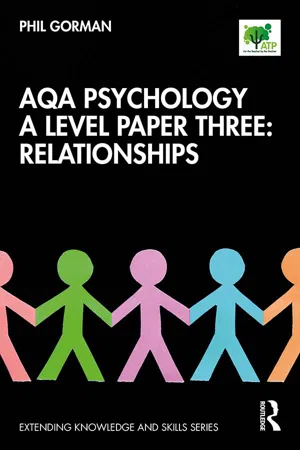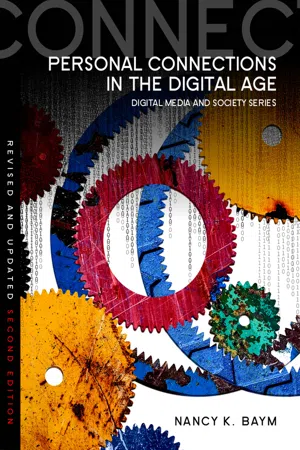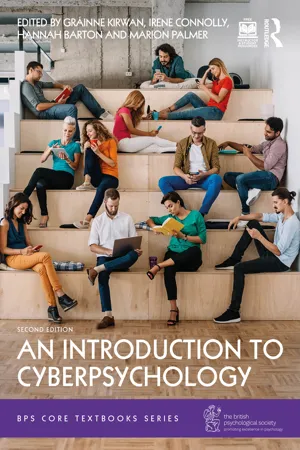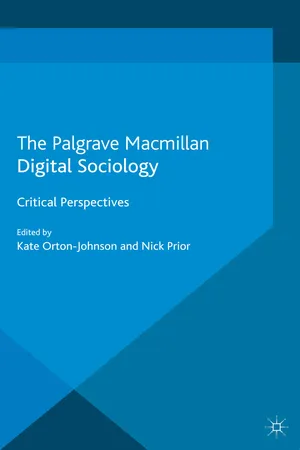Psychology
Virtual Relationships in Social Media
Virtual relationships in social media refer to connections formed and maintained through online platforms. These relationships can impact individuals' emotions, self-esteem, and social interactions. The lack of face-to-face interaction in virtual relationships may lead to challenges in accurately interpreting emotions and intentions, potentially affecting the quality and depth of the connection.
Written by Perlego with AI-assistance
Related key terms
Related key terms
1 of 4
Related key terms
1 of 3
4 Key excerpts on "Virtual Relationships in Social Media"
- Phil Gorman(Author)
- 2020(Publication Date)
- Routledge(Publisher)
Chapter 10Spec checkVirtual and parasocial relationships
Virtual Relationships in Social Media: self-disclosure in virtual relationships; effects of absence of gating on the nature of virtual relationships Parasocial relationship: levels of parasocial relationships; the absorption-addiction model and the attachment theory explanationAO1 (Knowledge and understanding): Virtual and parasocial relationships
Virtual Relationships in Social Media: The role of self-disclosure in virtual relationships. How the absence of gating affects the nature of virtual relationshipsParasocial relationships: The different levels of parasocial relationships and how these affect an individual’s behaviour. An outline of the absorption-addiction model and the relationship between attachment type and parasocial relationshipsVirtual relationships in social media
In previous chapters, there has been a lot of consideration of how the internet has changed relationships with various forms ofcomputer-mediated communication(CMC) allowing people to interact in ways that were not possible before. CMC is a term that is used for a variety of forms of communication from texting to chat rooms, but in the context of relationships, psychologists are particularly interested in the use of social networking sites, such as Facebook and Twitter, and online dating sites, such as Tinder and Zoosk (to name just a couple). The focus of the first part of this chapter is to look at how this has affected the process of forming relationships, before going on to consider whether it is radically different from other ways of forming relationships.The role of self-disclosure in virtual relationships
In Chapter 3 , we considered the role ofself-disclosure- eBook - ePub
- Nancy K. Baym(Author)
- 2015(Publication Date)
- Polity(Publisher)
Longitudinal studies that follow online friendships over time do not show meaningful differences between them and offline friendships. Chan and Cheng (2004) found that the differences between online and offline friendships increased within the first year but then diminished, and the relationships converged over time. They speculate that online friendships are more tentative in early stages, but after six months to a year grow quickly and become more like offline friendships (2004). McKenna et al. (2002) also tracked friendship pairs over time and found that online relationships lasted well over two years, comparing favorably with offline relationships. After two years, 71 percent of romantic relationships and 75 percent of all relationships begun online were still going. Most had grown closer and stronger.Michael Rabby (2007) compared four groups of relationships – those that began and remained online, those that began online and moved to being primarily maintained face-to-face, those that began face-to-face and remained there, and those that began face-to-face and moved to being primarily maintained online. Rabby found that the degree of commitment people had to their relationship was far more important than the means of communication in determining the kinds and amounts of relational maintenance behaviors people used. He did find that those he called the “virtuals,” who only communicated online, used fewer relational maintenance strategies than others, but those differences “were sometimes not significant,” and virtuals’ commitment levels were often “still relatively high” (Rabby, 2007: 333).In the end, then, people can and do develop meaningful personal relationships online. Many of them remain weak and specialized, used to exchange resources around a fairly narrow set of topics of shared interest. These relationships make important contributions to people’s lives, especially when they allow people to interact about interests and concerns that their close relational partners do not share. Pairs who do become closer interact through multiple media, eventually making the influence of the internet difficult to conceptually distinguish from the many other influences on their partnership. Reduced cues may be an issue in early stages of relationships, or in those that never have any prospect of going beyond initial encounters, but over time people can reveal themselves to one another verbally and nonverbally until they form understandings of one another as rich as, or richer than, those they hold of people they meet in any other way.Mediated relational maintenance
“Online” relationships turn into “offline” ones much less often than “offline” friendships turn into “online” ones. The rise of SNSs, which are used primarily to replicate connections that exist offline rather than to build new ones (boyd & Ellison, 2007), has cast this phenomenon into the spotlight. One out of every seven people (1.23 billion) on earth now use Facebook monthly, mostly to connect with people they already know. But taking offline ties online is a practice as old as the internet. An American random-sample telephone survey in the late 1990s, for instance, found that 41 percent of the reasons offered for home use of the internet had to do with supporting and maintaining meaningful relationships (Stafford, Kline, & Dimmick, 1999). - eBook - ePub
- Gráinne Kirwan, Irene Connolly, Hannah Barton, Marion Palmer(Authors)
- 2024(Publication Date)
- Routledge(Publisher)
- Many people engage in the surveillance of potential, current, or ex-partners on Facebook and other social network sites. Think about your own experience. Do you think that this is socially acceptable or healthy behaviour? If you knew that someone was seeking information from your profile, would that raise concerns for you about your privacy?
- If a person has an online relationship with someone other than his or her partner, but never meets them offline, is it really cheating?
Recommended Reading List
This book explores how technology impacts and interacts with our relationships, from online dating to technology in romantic relationships and its use in dissolving them, to technology-enhanced robot and augmented reality relationships.- Papacharissi, Z. (Ed.). (2018). A networked self and love (pp. 208–218). Routledge.
Two of the chapters in The Oxford Handbook of Cyberpsychology are particularly relevant. Chapter 7 looks at how technology can interfere with and disrupt partner and family relationships.- Drouin, M., & McDaniel, B. T. (2019). Technology interference in couple and family relationships. In A. Attrill-Smith, C. Fullwood, M. Keep, & D. J. Kuss (Eds.), The Oxford handbook of cyberpsychology (pp. 115–132). Oxford University Press.
Chapter 11 examines online romantic relationships and, in particular, delves into the psychological benefits and potential harms of dating online dating.- Lloyd, J., Attril-Smith, A., & Fullwood, C. (2019). Online romantic relationships. In A. Attrill-Smith, C. Fullwood, M. Keep, & D. J. Kuss (Eds.), The Oxford handbook of cyberpsychology (pp. 195–215). Oxford University Press.
This Pew Research report examines how people are using technology both to find new romantic relationships and within their existing ones. It looks at how technology can distract and disrupt relationships, as well as how couples can use it more positively to connect with a partner.- Vogels, E. A., & Anderson, M. (2020, May). Dating and relationships in the digital age. Pew Research Center : Internet & Technology
- eBook - ePub
Digital Sociology
Critical Perspectives
- K. Orton-Johnson, N. Prior, K. Orton-Johnson, N. Prior(Authors)
- 2013(Publication Date)
- Palgrave Macmillan(Publisher)
Part I Relationships 1 Personal Relationships, Intimacy and the Self in a Mediated and Global Digital Age Lynn Jamieson Introduction Few would disagree with Roger Silverstone that the near global exposure of almost all individuals to various forms of mass media content invisibly informs and constrains much social action and belief (Silverstone, 1994: 133). There is less agreement about the precise nature of the impact, particularly in the domain of personal life. The concern of this chapter is digitally mediated forms of communication and intimacy in personal relationships. My work in the 1990s sought to untangle contradictory claims about social change, selfhood and the quality of personal relationships, reconnecting theory with empirical evidence. The optimists in debate then, exemplified by Anthony Giddens, saw personal relationships as becoming more intense and democratically collaborative projects as people sought to anchor themselves through intimacy in rapidly changing worlds. For the pessimists, then exemplified by Zygmunt Bauman and Ulrich Beck, the same forces of rapid change were corrosive of personal relationships and rendered intimacy insipid, vapid and unworkably fragile. Exaggeratedly optimistic and pessimistic postures also haunt discussions of digital technologies and everyday personal lives, similarly implicating theories of selfhood and social change. When Intimacy: Personal Relationships in Modern Societies was first published, a review complained that topics of cybersex and computer-mediated communication had been omitted. The reviewer elaborated on the missed opportunity; the book should have addressed both popular speculations, such as ‘the potential decline of skin against skin sex and the extension of the body into new dimensions’, and the accumulation of new evidence about the impact of the Internet on personal life
Index pages curate the most relevant extracts from our library of academic textbooks. They’ve been created using an in-house natural language model (NLM), each adding context and meaning to key research topics.
Explore more topic indexes
Explore more topic indexes
1 of 6
Explore more topic indexes
1 of 4



